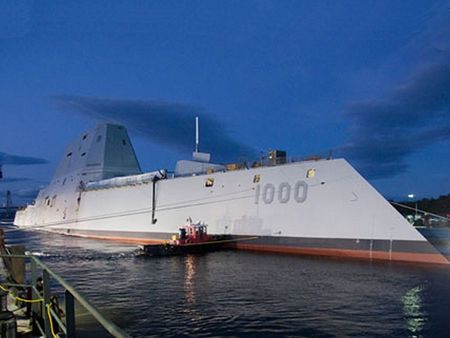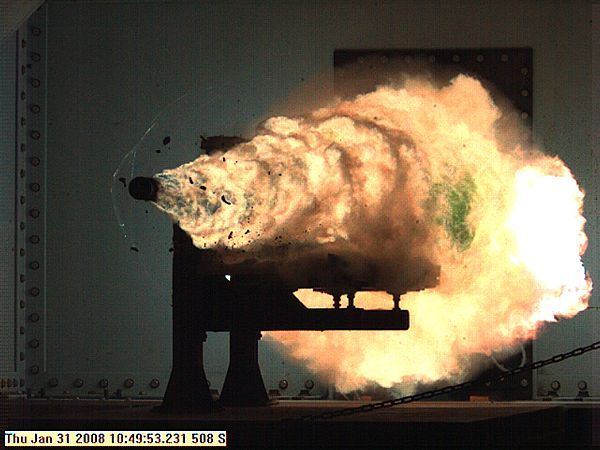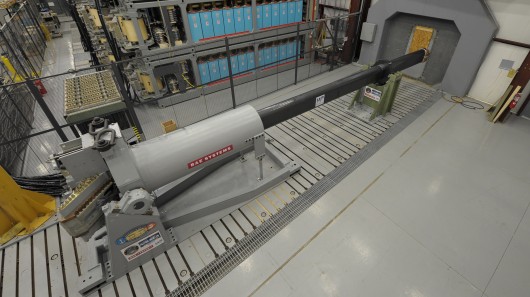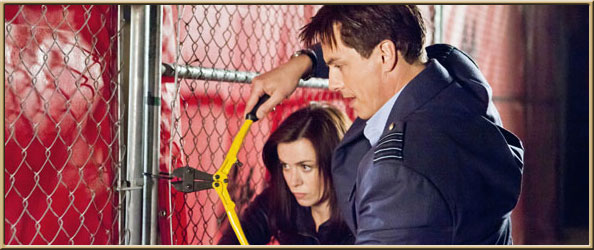Rail Guns and You

The United States Navy recently announced the unveiling of their prototype rail gun to the public (see here) coming this July. This five hundred million dollar monster is designed to throw a 23 pound projectile at least one hundred miles at Mach 7. But what does that really mean? To avid SciFi fans the rail gun, also sometimes referred to as a mass driver, a Gauss gun, or an electric projectile weapon, is not something new.
I believe that my first encounter with this concept in fiction was in Robert A. Heinlein’s The Moon is a Harsh Mistress, where the citizens of the Moon (actually prisoners) used a mass driver to hurl large rocks at the Earth to gain their independence. In the movies, Eraser was about hand held rail guns; in computer games, Quake II had a rail gun that saved my butt on many occasions (it was slow to reload, slow to shoot but the impact was devastating on even the most powerful enemies). These are just a few examples, rail guns pop up all over in the genre.

The concept for rail guns has been around for quite some time (the first patent was in 1918) but the technology and engineering are just now getting to the point where such a thing is more realistic. A rail gun works on the same concept as an electric motor where alternating magnetic fields push and pull a fixed magnetic object making one of them move. This difference is that in an electric motor the fixed magnets are in the outer shell and the alternating magnets are attached to a rotor on a shaft so it spins In a rail gun the fixed magnets are on the projectile and the alternating magnets are placed along the barrel of the gun, pushing the projectile forward. In a sense, the rail gun is an electric motor split open and laid out in a straight line. Instead of spinning, the projectile accelerates and flies away.

One of the big problems that had to be overcome to get these things working is the amount of energy required. Keep in mind that the energy of the projectile is at least as much as the energy required to fire it (actually much less since a bunch is lost to heat and friction). This is because of that pesky little law of physics know as the Conservation of Energy (or, in more common terms, “There ain’t no such thing as a free lunch”).
 The system that the U.S. Navy has announced pushes a 23lb projectile to Mach 7. Let’s first scrap the annoying English units and realize that we are looking at a 10kg projectile traveling at around 2,500 meters per second. Note that Mach numbers are not exact speeds, they are dependent on air pressure, humidity and a couple other factors. The Mach number is the ratio of the projectile speed to the speed of sound so Mach one means that the projectile is traveling at the same speed as sound waves. I’m going to use 2,500 because it’s in the ballpark and it makes the math easier, I know what 25 squared is off the top of my head. Now, using the standard formula for kinetic energy:
The system that the U.S. Navy has announced pushes a 23lb projectile to Mach 7. Let’s first scrap the annoying English units and realize that we are looking at a 10kg projectile traveling at around 2,500 meters per second. Note that Mach numbers are not exact speeds, they are dependent on air pressure, humidity and a couple other factors. The Mach number is the ratio of the projectile speed to the speed of sound so Mach one means that the projectile is traveling at the same speed as sound waves. I’m going to use 2,500 because it’s in the ballpark and it makes the math easier, I know what 25 squared is off the top of my head. Now, using the standard formula for kinetic energy:
$latex E=\frac{1}{2}mv^2=5\times(2500)^2=31,250,000\:Joules$ ($latex Joules$ have units of $latex kg(\frac{m}{s})^2$)
so roughly 32 Mega Joules (hey, I think that’s about what they said in the article, yeah me).
Now most people have little or no feel for what a Joule is so let’s convert to something that we might understand a little better. The nearest counterpart to a Joule in commonly used units is actually a calorie, which isn’t going to be all that helpful, but a Watt is a Joule per second and most everybody is somewhat familiar with a Watt from light bulbs. I don’t know the actual time span involved in the firing of the weapon the Navy built, but I imagine it’s measured in milliseconds, for the sake of argument let’s say it’s 10 milliseconds. Now a millisecond is 1/1000th of a second so 10 milliseconds is 1/100 of a second thus, to get the Watts we multiply the Joules by 100 and get 3,125,000,000 Watts! (that’s 3 billion, with a B, that’s one bright light bulb!!).
Another way to look at it is that your electric bill is based on usage in kilowatt-hours; a thousand Watts times an hour, not per hour – kWH. This seems like an odd measurement but if you hold your mouth right and squint your eyes you should realize that these are just a re-scaling of Joules; a kWH is 3,600,000 Joules (or 3.6 mega Joules) so it takes about 9 kWH to fire the weapon, let’s call it 10 to make the math easier and account for some of the loss due to heat and friction (I’m betting that the actual energy difference is a factor of two or three times).
So that doesn’t seem too bad, at about 10 cents per kWh it only costs about a buck for the electricity to fire this beast. Well yes, but (you’re going to learn to hate it when I say that) remember that this all happens in a very short time span, it would takes several hours for most households to consume that much electricity. So what’s the difference? Amperage, my friends. Amps are (roughly) Watts divided by Volts. I’m not sure what voltage this unit runs on but let’s plug it in at home, not the usual wall socket but that big three (or four) pronged unit that your drier or stove plug into (unless you have gas but that’s your problem, try yogurt). That’s a 220 volt circuit so:
$latex \frac{Watts}{Volts} = 3,125,000,000/220 = 14,204,545.45\: amps$
(again this is an approximation, the 220 circuit is three phase alternating current and the Watts/Volts calculation applies to direct current. You can look up the formula for three phase AC but there are some factors in it that will make everyone’s eyes glaze over, either way you get a big number.). Well guess what, your gun didn’t fire because the breaker blew at 20 amps; in fact, sucking that much power probably blacked out much of your surrounding area. But that’s still only part of the issue.
High amperage can also generate a lot of heat; essentially friction within the wire plus, with AC, the wires vibrate at 60 cycles per second, increasing the amperage increases the amplitude of the vibration which increases the friction which increases the heat. On top of that there is also the heat generated by the resistance of the metal used to make the wires. This is why your house (or apartment complex) has breakers. It’s to prevent you from setting the whole place on fire by sucking so much power that the wires overheat. A simple way to overcome part of this is to use bigger wires. Take a look at the cable powering your stove or dryer compared to the one powering your desk lamp (if you have gas, just realize that a 20 amp cord is much bigger than a lamp cord).
So there’s the power problem. We need a lot of electrical energy discharged in a very short amount of time without burning up the wires. Well, maybe it’s not obvious to you but one way we can reduce the amperage is to increase the voltage, but that means that we need some really big batteries. Actually, they would be using large capacitors (go look it up) which can store large amounts of electrical charge and can also be discharged very rapidly. Plus, you will need really really big wires!
We also need to consider other issues like the material strength required for the barrel, the radial force on the barrel is essentially the same as that required to push the projectile. Looking the picture in the article I’d estimate the length of the barrel to be about 10 times longer than the man in the picture so maybe 60 feet, let’s call it 20 meters. So using the formula:
$latex a = \frac{v^2}{2s}$
Where v is the velocity and s is the length of the barrel so:
$latex a = \frac{(2500)^s}{40} = \frac{6,250,000}{40} = 156,250 \frac{m}{s^2}$
Now using
$latex F=ma$ (another old friend, I’ll use this one a lot)
we get:
$latex F = 1,562,500\: Newtons$.
So what’s a Newton? Newtons are metric units of force; pounds are English units of force (kilograms are units of mass). The conversion factor is 0.224808943 so 351263.97 pounds or about 176 tons! Finally, maybe you weren’t paying attention earlier but the velocity of the projectile contributes far more to the energy than the mass of the projectile: doubling the mass of the projectile doubles the energy but doubling the velocity quadruples the energy. This should also give you an idea of why such a weapon is desirable. According to the Navy the projectiles for the rail gun runs about $25,000 a pop which may seem steep but, considering the price of the average missile, this is cheap.
Also consider the increased safety factor. Rail guns do not require a magazine full of highly explosive gunpowder to be stored on the ship (remember the H.M.S. Hood?), and the projectiles are also inert. By the way, if you’ve watched the videos the muzzle flash you see is ionized oxygen from the Mach 7 projectile hitting the air (plus some ionized metal from the barrel and projectile). The apparent explosion on impact is a scattering of liquefied, super-heated metal, the energy of the projectile is mostly converted to heat and there’s a lot of energy expended.
So what have we learned today?
- Rail guns require large amounts of electricity and very large wires.
- If something is going very fast then it’s already explosive.
- The U.S. Navy thinks that $25,000 per shot is cheap.
Okay, so there was more than that, go back a re-read it if you’ve forgotten. And keep in mind that I just hit on some of the basics, there’s a whole bunch more interesting science that goes into rails gun technology. Now that that’s covered what’s up next? Perhaps a stirring exposé of gravity is in order.



